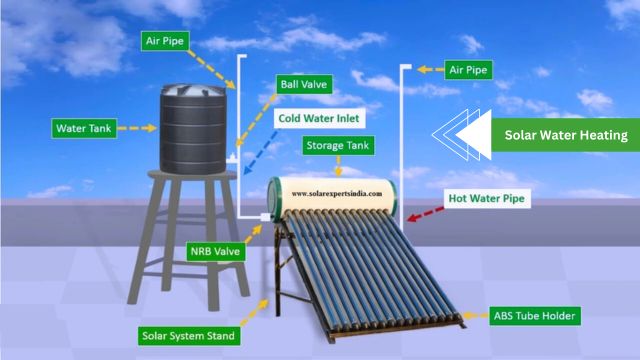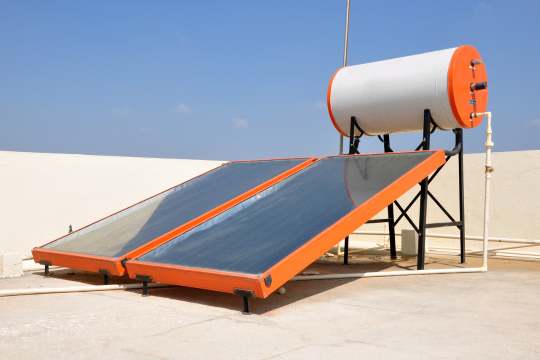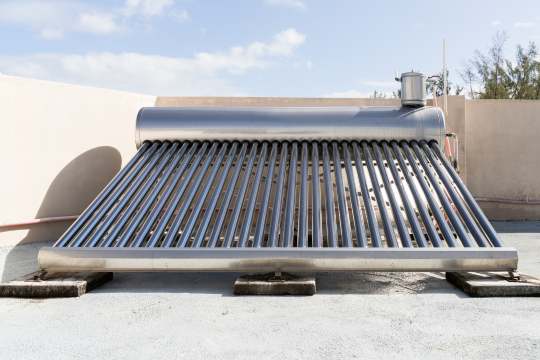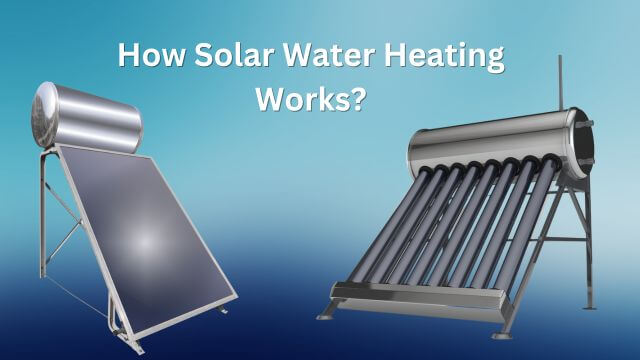Solar water heating is a renewable energy system that uses the sun’s energy to heat water. The system uses solar collectors or panels, which are usually mounted on a roof, to absorb sunlight and convert it into heat. The heated water is then stored in a tank, ready for use when needed.
How Solar Water Heating Works?
Solar water heating systems typically consist of four main components: the solar collector, storage tank, circulation pump, and control system. The solar collector is a device that absorbs the sun’s energy and heats the water. The storage tank is used to store the heated water until it is needed, while the circulation pump moves the water through the system. The control system ensures that the system operates efficiently and effectively.

The solar collector is the most critical component of the system. It can be either flat-plate or evacuated tube collectors. Flat-plate collectors are more common and consist of an insulated box with a flat absorber plate that is coated with a dark material to absorb the sun’s energy. The absorber plate is covered with a transparent cover to allow sunlight to pass through but prevent heat from escaping. Evacuated tube collectors are more efficient than flat-plate collectors and consist of a series of glass tubes that contain a vacuum. The tubes absorb the sun’s energy, and the vacuum prevents heat from escaping.
- Solar Collectors: Solar collectors are the most crucial part of the system. These are panels that are typically mounted on a roof and absorb the sun’s energy to heat the water. There are two primary types of solar collectors: flat-plate collectors and evacuated tube collectors.
Flat-plate collectors are the most common type of solar collector. They consist of an insulated box with a dark-colored absorber plate, covered with a transparent cover to allow sunlight to pass through. The absorber plate absorbs the sun’s energy and transfers it to the water flowing through the pipes.

Evacuated tube collectors, on the other hand, are more efficient than flat-plate collectors. They consist of a series of glass tubes containing a vacuum. The vacuum prevents heat from escaping and allows the tubes to absorb more energy than flat-plate collectors.

- Storage Tank: Once the water is heated by the solar collectors, it is stored in a tank. This tank is usually insulated to keep the water warm for as long as possible. The size of the tank will depend on the number of people in the household and their hot water needs.
- Circulation Pump: The circulation pump moves the water from the collectors to the storage tank. This pump is typically powered by electricity, and its job is to ensure that the water flows efficiently through the system.
- Control System: The control system ensures that the solar water heating system operates efficiently and effectively. This system monitors the temperature of the water in the collectors and the storage tank and adjusts the circulation pump accordingly. It also controls the backup heating system, which is usually an electric or gas-powered heater that kicks in when there is not enough solar energy to heat the water.
How They Work Together: When the sun shines on the solar collectors, they absorb the sun’s energy and transfer it to the water flowing through the pipes. The heated water then flows into the storage tank, where it is kept warm until it is needed. When hot water is required in the household, it is drawn from the storage tank, and cold water is added to replace it. The circulation pump moves the water from the collectors to the storage tank and ensures that the system operates efficiently. The control system monitors the temperature of the water and adjusts the circulation pump and backup heating system to ensure that the water is always at the desired temperature.
Types of Solar Water Heating Systems
Flat Plate Solar Water Heating Systems
Flat plate solar water heating systems are the most common type of solar water heating system. They consist of a flat plate collector, which is mounted on a roof or wall, and a storage tank. The collector is made up of an insulated box with a glass or plastic cover, and a flat metal plate that absorbs the sun’s energy and transfers it to the water.
One of the advantages of flat plate solar water heating systems is that they are relatively inexpensive compared to other types of solar water heating systems. They are also easy to install and maintain and are suitable for most climates.
Evacuated Tube Solar Water Heating Systems
Evacuated tube solar water heating systems are another popular type of solar water heating system. They consist of a series of glass tubes, each containing a metal absorber plate. The tubes are mounted on a roof or wall and are filled with a heat transfer fluid.
One of the advantages of evacuated tube solar water heating systems is that they are more efficient than flat plate solar water heating systems. This is because the tubes are evacuated, which means that there is no air inside them to conduct heat away from the absorber plate.
Integral Collector Storage Solar Water Heating Systems
Integral collector storage (ICS) solar water heating systems are a type of flat plate solar water heating system that combines the collector and storage tank into one unit. The collector is usually a black tank that is mounted on a roof or wall, and the storage tank is located inside the collector.
One of the advantages of ICS solar water heating systems is that they are simple and easy to install. They are also suitable for most climates and are relatively inexpensive compared to other types of solar water heating systems.
Thermosyphon Solar Water Heating Systems
Thermosyphon solar water heating systems are a type of flat plate solar water heating system that uses natural convection to circulate the water between the collector and storage tank. The collector is mounted on a roof or wall, and the storage tank is located below it.
One of the advantages of thermosyphon solar water heating systems is that they are simple and reliable. They are also suitable for most climates and are relatively inexpensive compared to other types of solar water heating systems.
Heat Pump Water Heating Systems
Heat pump water heating systems are a type of solar water heating system that uses electricity to transfer heat from the air or ground to the water. They consist of a heat pump unit, a storage tank, and a collector.
One of the advantages of heat pump water heating systems is that they are very efficient, and can save a lot of energy compared to traditional electric water heaters. They are also suitable for most climates and are relatively easy to install.
Advantages and Disadvantages of Solar Water Heating
Advantages
- Cost Savings
One of the most significant advantages of solar water heating is cost savings. Once you’ve installed a solar water heater, you will see a reduction in your monthly energy bills. Since the sun’s energy is free, you will be using less electricity or gas to heat your water, resulting in long-term cost savings.
- Renewable Energy
Solar water heating is a renewable energy source. It’s an environmentally friendly way to heat your water, as it doesn’t produce any harmful greenhouse gases that contribute to climate change. By using solar energy, you’re helping to reduce your carbon footprint and protect the environment.
- Low Maintenance
Solar water heaters are low maintenance compared to traditional water heaters. They have fewer moving parts and typically last longer, meaning less maintenance and repair work over time. This translates to fewer costs and less hassle for you.
- Government Incentives
Many governments offer incentives for installing solar water heaters. In some cases, you may be eligible for a tax credit, grant, or rebate, making the initial installation cost more affordable.
Disadvantages
- Upfront Cost
The upfront cost of installing a solar water heater is higher than that of a traditional water heater. This is due to the cost of the solar panels and the installation. However, over time, the cost savings from reduced energy bills will offset the initial investment.
- Weather Dependent
Solar water heating is weather-dependent, meaning that it relies on sunlight to work. If you live in an area with little sunlight or frequently cloudy weather, your solar water heater may not work as efficiently.
- Space Requirements
Solar water heaters require more space than traditional water heaters. This is due to the size of the solar panels and the need for a storage tank. If you have limited outdoor space or live in an apartment, solar water heating may not be feasible.
- Backup System Required
A backup system is required for solar water heating, especially if you live in an area with frequent power outages or cloudy weather. This backup system can be an electric or gas water heater, which adds to the overall cost.


